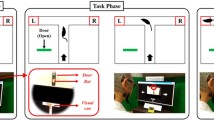Abstract
A remote control system has been developed to deliver stimuli into the rat brain through a wireless micro-stimulator for animal behavior training. The system consists of the following main components: an integrated PC control program, a transmitter and a receiver based on Bluetooth (BT) modules, a stimulator controlled by C8051 microprocessor, as well as an operant chamber and an eight-arm radial maze. The micro-stimulator is featured with its changeable amplitude of pulse output for both constant-voltage and constant-current mode, which provides an easy way to set the proper suitable stimulation intensity for different training. The system has been used in behavior experiments for monitoring and recording bar-pressing in the operant chamber, contriolling rat roaming in the eight-arm maze, as well as navigating rats through a 3D obstacle route. The results indicated that the system worked stably and that the stimulation was effective for different types of rat behavior controls. In addition, the results showed that stimulation in the whisker barrel region of rat primary somatosensory cortex (SI) acted like a cue. The animals can be trained to take different desired turns upon the association between the SI cue stimulation and the reward stimulation in the medial forebrain bundle (MFB).
Similar content being viewed by others
References
Bear, M.F., Connors, B.W., Paradiso, M.A., 2001. Neuroscience: Exploring the Brain (2nd Ed.). Lippincott Williams & Wilkins, Baltimore, MD.
Hermer-Vazquez, L., Hermer-Vazquez, R., Rybinnik, I., Greebel, G., Keller, R., Xu, S., Chapin, J.K., 2005. Rapid learning and flexible memory in “habit” tasks in rats trained with brain stimulation reward. Physiol. Behav., 84(5):753–759. [doi:10.1016/j.physbeh.2005.03.007]
Lindner, M.D., Plone, M.A., Francis, J.M., Blaney, T.J., Salamone, J.D., Emerich, D.F., 1997. Rats with partial striatal dopamine depletions exhibit robust and long-lasting behavioral deficits in a simple fixed-ratio bar-pressing task. Behav. Brain Res., 86(1):25–40. [doi:10.1016/S0166-4328(96)02240-1]
Lou, M., Eschenfelder, C.C., Herdegen, T., Brecht, S., Deuschl, G., 2004. Therapeutic window for use of hyperbaric oxygenation in focal transient ischemia in rats. Stroke, 35(2):578–583. [doi:10.1161/01.STR.0000111599.77426.A0]
Masino, S.A., 2003. Quantitative comparison between functional imaging and single-unit spiking in rat somatosensory cortex. J. Neurophysiol., 89(3):1702–1712. [doi:10.1152/jn.00860.2002]
Paxinos, G., Watson, C., 1997. The Rat Brain in Stereotaxic Coordinates (3rd Ed.). Academic Press, San Diego, CA.
Reynolds, J.N., Hyland, B.I., Wickens, J.R., 2001. A cellular mechanism of reward-related learning. Nature, 413(6851):67–70. [doi:10.1038/35092560]
Romo, R., Hernandez, A., Zainos, A., Brody, C.D., Lemus, L., 2000. Sensing without touching: psychophysical performance based on cortical microstimulation. Neuron, 26(1):273–278. [doi:10.1016/S0896-6273(00)81156-3]
Simons, D.J., 1978. Response properties of vibrissa units in rat SI somatosensory neocortex. J. Neurophysiol., 41(3):798–820.
Simons, D.J., 1983. Multi-whisker stimulation and its effects on vibrissa units in rat SmI barrel cortex. Brain Res., 276(1):178–182. [doi:10.1016/0006-8993(83)90561-9]
Song, W.G., Chai, J., Han, T.Z., Yuan, K., 2006. A remote controlled multimode micro-stimulator for freely moving animals. Sheng Li Xue Bao, 58(2):183–188.
Talwar, S.K., Xu, S., Hawley, E.S., Weiss, S.A., Moxon, K.A., Chapin, J.K., 2002. Rat navigation guided by remote control. Nature, 417(6884):37–38. [doi:10.1038/417037.a]
Tehovnik, E.J., 1996. Electrical stimulation of neural tissue to evoke behavioral responses. J. Neurosci. Methods, 65(1):1–17. [doi:10.1016/0165-0270(95)00131-X]
Wang, Y., Su, X.C., Wang, M., 2006. A telemetry navigation system for animal-robots. Robot, 28(2):183–186.
Xu, S., Talwar, S.K., Hawley, E.S., Li, L., Chapin, J.K., 2004. A multi-channel telemetry system for brain microstimulation in freely roaming animals. J. Neurosci. Methods, 133(1–2):57–63. [doi:10.1016/jjneumeth.2003.09.012]
Author information
Authors and Affiliations
Corresponding authors
Additional information
Project supported by the Zhejiang University Grant for Multiple Discipline Associated Research, Zhejiang University, China
Rights and permissions
About this article
Cite this article
Feng, Zy., Chen, Wd., Ye, Xs. et al. A remote control training system for rat navigation in complicated environment. J. Zhejiang Univ. - Sci. A 8, 323–330 (2007). https://doi.org/10.1631/jzus.2007.A0323
Received:
Accepted:
Published:
Issue Date:
DOI: https://doi.org/10.1631/jzus.2007.A0323




